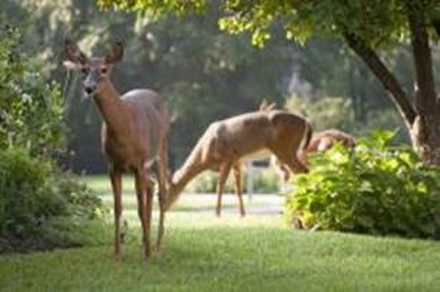But did you know that deer can carry parasites that transmit debilitating diseases to people? Or that nationally, deer versus car collisions claim about 200 lives per year, according to the Centers for Disease Control and Prevention: http://www.cdc.gov/mmwr/preview/mmwrhtml/mm5330a1.htm
Bambi’s less beautiful when you consider the deer dangers you don’t know. While damage to bushes, blooms, shrubs, and gardens can be annoying at best and costly at worst, deer can pose other risks to the safety of your home and family, including:
* Disease dangers – Deer often carry ticks that transmit debilitating diseases like Lyme disease and brucellosis. Lyme disease can cause headaches, fever, fatigue, joint pain and rashes, and is often hard to diagnose. Left untreated, Lyme can damage the nervous system and even cause memory loss. Brucellosis is a bacterial infection that causes flu-like symptoms, including fever and headaches. In addition to affecting the central nervous system, it can attack the heart lining too.
* Pet threat – Direct injuries to people caused by deer may be uncommon, but deer that dwell in suburbia often come in contact with pets. Even a small doe can cause considerable injury to a dog or cat if the deer feels threatened and cornered. Bucks with antlers can be even more menacing to pets, especially during rutting season.
* Real estate reductions – Everyone knows that curb appeal is king when you’re trying to sell a house. Deer eat 6 to 10 pounds of food daily, tearing leaves from plants and bark from trees. Their foraging can weaken and even decimate plants. Deer damage to landscaping, especially trees, can seriously spoil curb appeal, sometimes causing potential buyers to think twice before purchasing a home in an area known for deer damage.
* Perpetual predation – Deer are prey animals, and an abundant population of them in a small area can draw predators looking for easy-access meals at your house, on a regular basis. Coyotes and bobcats won’t hesitate to attack family members and pets, plus they can carry diseases such as rabies. To protect your home from deer damages – both known and unknown – it’s important to be pro-active. If you act before the deer do you may be able to prevent their destruction altogether. Once deer settle into an area, it can be difficult to convince them to leave. Since no one wants to unnecessarily harm deer, it’s important to try safe, preventive measures such as:
* Deer repellent – It’s possible to deter deer without the use of harsh chemicals. Bobbex Deer Repellent , a topical foliar spray, uses taste and smell-aversion ingredients to deter deer from browsing on foliage, shrubs and trees. All natural, it’s safe for use around sensitive plantings, your children and pets. It works in any climate, won’t wash off in heavy rain, and it has been found to be 93 percent effective – second only to a physical barrier – in testing by the Connecticut Department of Forestry and Horticulture. To learn more, visit www.bobbex.com
* Fencing – While fencing is considered a sure-fire way to keep deer out, it’s not always desirable or practical to fence your yard. Many communities restrict the height of fences, some are unsightly and deer have been known to jump fences as high as 10 feet.
* Devices – Noise-makers and lights that are motion-activated may scare deer away for a short time, but deer will eventually learn there’s no real threat and return to an area where deterrent devices are in use.
* Unpalatable plantings – Hungry deer will eat almost anything, but it is possible to plant some vegetation that deer are less likely to eat. Interspersing plants like yarrow, fuzzy lamb’s ear, catmint, and hellebore, may offer some protection for plants that deer find desirable.The easiest way to deter deer danger at your home is to start using a proven effective, spray on deer repellent and thwart the problem before it becomes bigger than you bargained for. For more information on Bobbex Deer Repellent, please visit: www.bobbex.com



